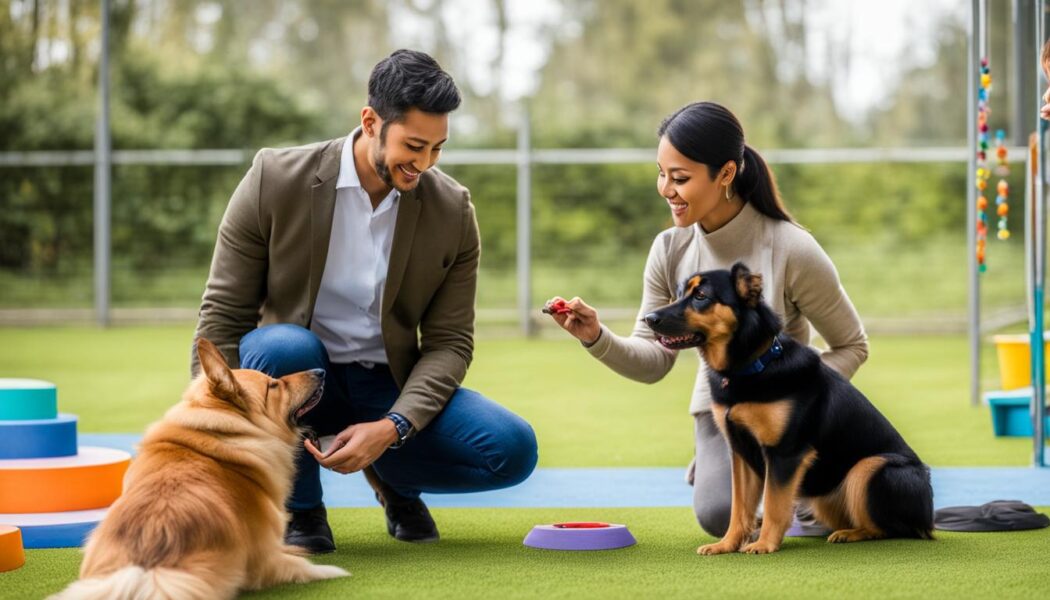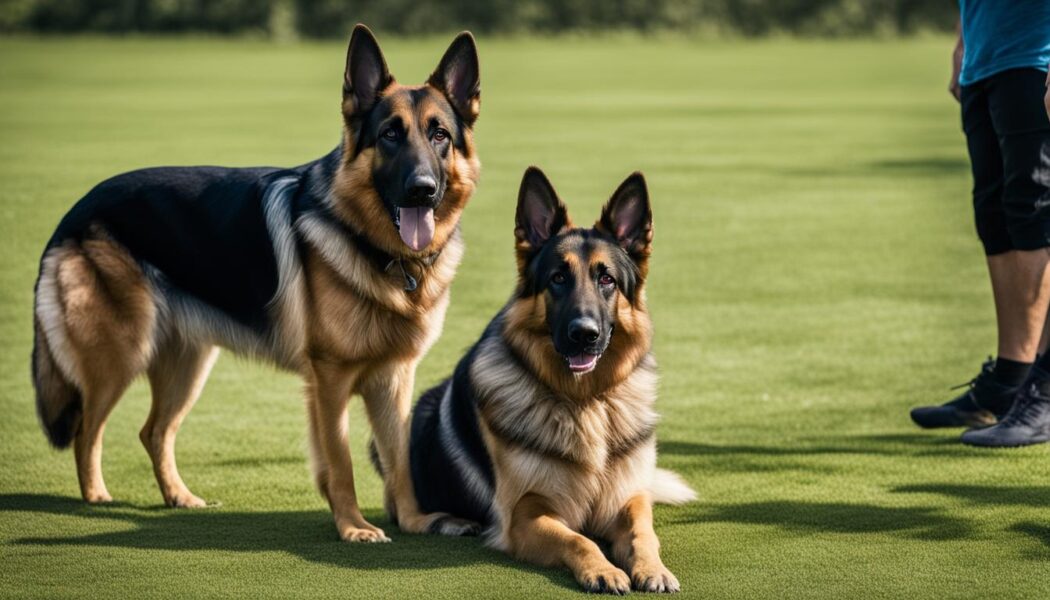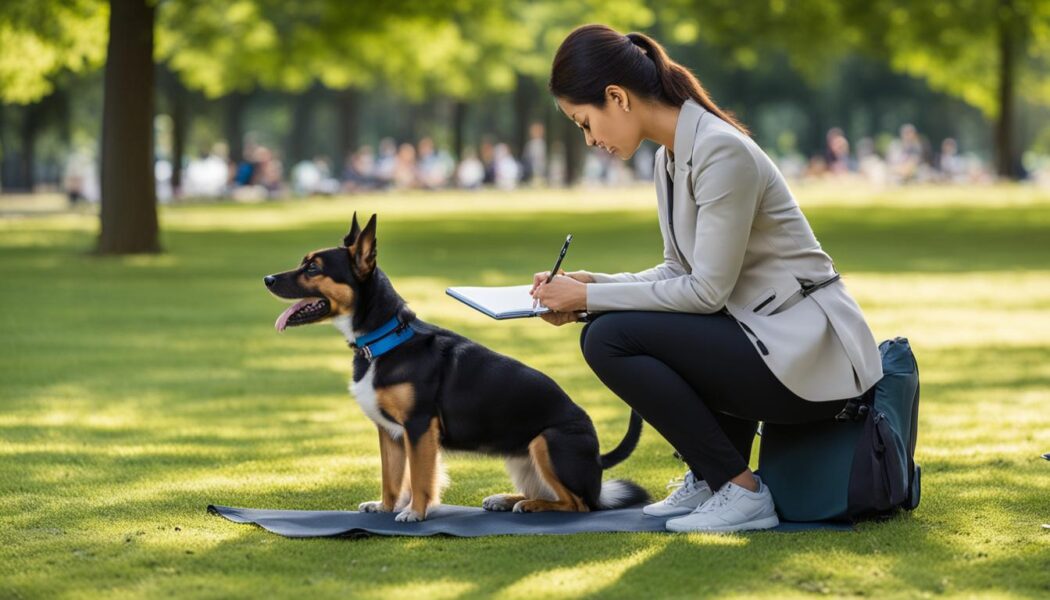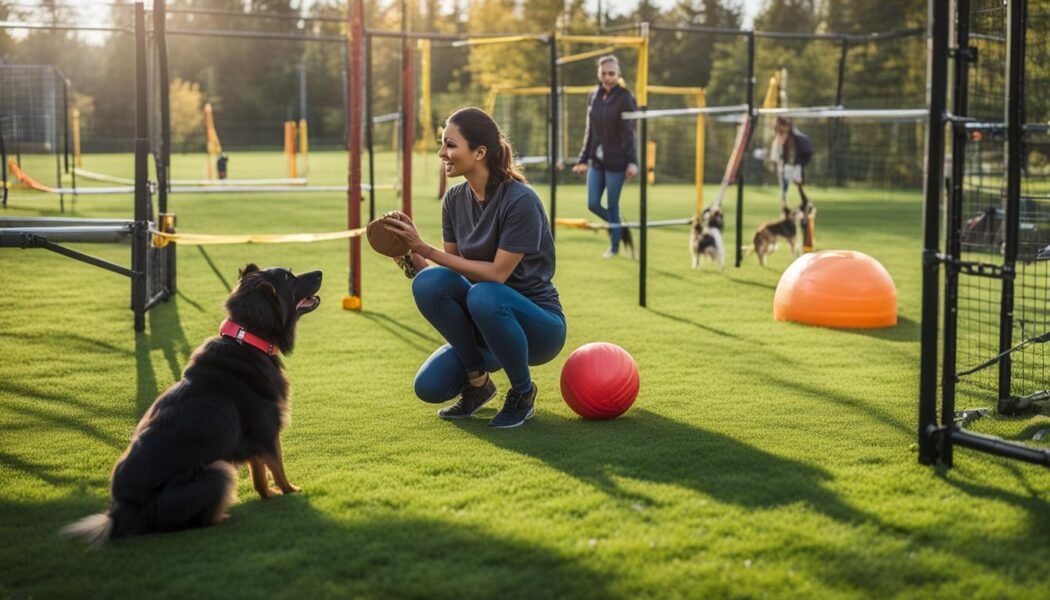As I’ve delved into the principles of balanced dog training, I’ve come to appreciate its holistic approach. Rooted in the harmony between rewarding good behavior and correcting undesirable actions, this method underscores the importance of tailoring training to the individual dog—acknowledging their unique temperament and specific needs.
Effective trainers, such as those at Unleashed Potential in Prince Edward Island, Canada, have harnessed this technique to achieve transformative results across varied canine personalities. The balanced method isn’t solely about discipline or positive reinforcement; it’s about the fusion of both, to engender an atmosphere of trust, clear communication, and mutual respect between dogs and their owners.
Through a balanced training regimen, dogs are coaxed into good behavior with treats and praise, and guided away from poor choices with gentle, well-timed corrections for clarity.
Key Takeaways
- Balanced dog training is a holistic approach that combines positive reinforcement and corrective measures.
- This method focuses on tailoring training to each dog’s unique temperament and needs.
- Unleashed Potential in Prince Edward Island, Canada is known for their effective implementation of balanced dog training techniques.
- Establishing trust, clear communication, and mutual respect is crucial in this training approach.
- Both rewards for good behavior and well-timed corrections for undesirable actions are used in a balanced training regimen.
The Philosophy of Balanced Dog Training

A quintessential aspect of balanced dog training is its dual focus – both on positive reinforcement to reward desired behavior, and on mindful corrective measures in dog training to address missteps. This philosophy supports a trainer’s fundamental goal: cultivating a conducive learning environment that is neither punitive nor permissive but steers dogs towards making good choices.
Integrating Positive Reinforcement and Corrective Measures
Positive reinforcement strengthens the bond between dog and owner, using treats, praise, or attention as a reward for good behavior. On the other hand, appropriate corrective measures – such as verbal cues or leash guidance – provide clear direction and structure, teaching the dog to avoid unwanted actions.
- Positive reinforcement: Use treats, praise, or attention as a reward for good behavior.
- Corrective measures: Employ verbal cues or leash guidance to provide clear direction and structure.
By seamlessly integrating these approaches, balanced dog training enables us to shape our dogs’ behavior without resorting to harsh methods or creating a permissive environment.
Creating a Trust-Based Relationship with Your Dog
Key to the balanced dog training philosophy is establishing trust. It transcends beyond teaching tricks or enforcing obedience; it’s about building a trust-based relationship that underpins every interaction with your canine partner. This school of thought recognizes each dog as an individual – some may thrive with ample positive affirmation, while others might need more structured guidance.
By understanding and respecting these nuances, companies like Unleashed Potential craft a dog obedience training regimen that fosters trust, facilitating a harmonious human-dog relationship that’s grounded in mutual respect and clear communication.
| Trust-based dog relationship components | Description |
|---|---|
| Understanding | Recognizing each dog’s unique temperament and needs. |
| Respecting individuality | Acknowledging and adjusting training methods to cater to individual dogs. |
| Clear communication | Using consistent verbal and non-verbal cues to maintain open lines of communication with your dog. |
| Mutual respect | Building a bond based on trust, respect, and understanding between owner and dog. |
In conclusion, the philosophy of balanced dog training emphasizes the importance of integrating both positive reinforcement and corrective measures to guide our dogs. It strives to create a trust-based relationship that respects each dog’s uniqueness while fostering a harmonious human-dog partnership grounded in mutual understanding, respect, and clear communication.
Essentials of Dog Obedience Training

At the core of dog obedience training lies the mastery of basic commands, which serve as the building blocks for advanced skills. Training is not only about heeling or staying on cue but sculpting a well-behaved, social companion ready to interact safely with both people and their environment. Basic commands establish a framework that guides dogs on how they should behave in diverse situations.
Mastering Basic Commands
Effective dog training techniques center around teaching dogs basic commands that form the foundation of obedience. These commands play a crucial role in ensuring your dog’s safety and fostering a well-mannered demeanor. Some of the key commands for a well-rounded dog training repertoire include:
- Sit
- Down
- Stay
- Come
- Heel
- Leave it
Consistent practice and reinforcement help dogs develop a strong understanding of these commands, enabling them to react instinctively when prompted.
Setting Boundaries and Expectations
Setting boundaries with dogs is an integral component of dog training, equipping dogs with the knowledge of what is acceptable within the household and in public spaces. Boundaries, coupled with clear expectations, result in a well-adjusted dog, ingraining a sense of structure and order within their daily lives.
| Boundaries | Expectations |
|---|---|
| No jumping on people | Polite greeting behavior |
| Designated sleep area | Respecting sleep time and spaces |
| No begging at the table | Waiting patiently during mealtimes |
| Restricted access to certain rooms | Respecting off-limits areas |
| Leash manners | Walking politely by owner’s side |
It’s essential that owners convey these boundaries consistently so that dogs learn to navigate their world with a clear understanding of the guidelines. By employing a blend of dog training methods tailored to the individual dog, you can set a solid foundation for a well-behaved, obedient companion who thrives in any environment.
The Role of Dog Behavior Training in Unleashing Potential
Unlocking the full potential of our canine companions is a pivotal role of dog behavior training. This process involves tailoring strategies that align with the dog’s innate disposition. For instance, high-energy breeds might benefit from mentally stimulating activities, while shy breeds may require confidence-building exercises. Understanding the subtleties of breed traits aids in crafting a training program that not only modifies behavior, but also leverages these inherent qualities for positive development.

Recognizing varying breed traits and characteristics can provide insights into the creation of effective and targeted dog training classes. With this knowledge, professional dog training programs can be specialized based on specific breed tendencies, ensuring exceptional results in behavior modification and skill development.
Examples of dog training strategies tailored to breed traits include:
- High-energy breeds may benefit from engaging in agility and flyball exercises.
- Herding breeds often excel in activities that tap into their natural instincts, such as herding trials or treibball.
- Guardian breeds may benefit from protection-based exercises and scent detection activities.
- Shy or reserved breeds can thrive through confidence-building exercises, such as desensitization and counter-conditioning.
To better understand how breed traits influence training approaches, the table below presents an overview of common breed characteristics and their implications in dog training:
| Breed Category | Common Characteristics | Training Implications |
|---|---|---|
| Herding Breeds | Intelligent, energetic, instinct to control movement of livestock | Activities that tap into herding instincts, mental stimulation, and consistent boundary-setting |
| Sporting Breeds | Active, eager to please, strong sense of smell, and natural retrieving abilities | Engagement in scent detection, hunting simulation, and retrieval exercises; focus on positive reinforcement techniques |
| Working Breeds | Strong, courageous, protective, and loyal | Training in protection services, engaging in advanced obedience exercises, and teaching clear boundaries |
| Toy Breeds | Small, affectionate, adaptable, and sociable | Reward-based training, early socialization, and focus on impulse control and basic commands |
Ultimately, by incorporating breed-specific strategies into dog behavior training and professional dog training classes, owners and trainers can effectively unleash their canine’s potential, resulting in well-behaved, skilled, and thriving dogs.
How to Choose the Right Dog Training Techniques for Your Furry Friend
In selecting the right dog training techniques, understanding your dog’s distinct temperament is crucial. Factors such as size, energy levels, socialization needs and health considerations significantly affect a dog’s learning and behavior. Acknowledging your dog’s individual traits and propensities enables you to choose a training approach that’s constructive and aligned with their character.

Understanding Your Dog’s Unique Temperament
In an effort to understand your dog’s temperament, consider their breed tendencies, as well as their disposition and preferences. This analysis should encompass:
- Breed predispositions, such as herding or hunting tendencies
- Energy levels and exercise needs
- Sociability with humans and other animals
- Learning pace and training preferences
Comprehending your dog’s unique temperament allows you to develop a training plan tailor-made for their needs and characteristics, ensuring their progress in a positive and healthy manner.
Assessing Different Dog Training Methods
Equipped with a deep understanding of your dog’s temperament, it is now time to assess various dog training methods. From reward-based training that heavily relies on treats and praise, to a more measured approach that might integrate discouraging unwanted behavior, the spectrum of strategies points to a tailored training experience.
Recognizing the impact of breed tendencies is essential, as it contributes to developing a method that harmonizes with your furry friend’s innate personality.
Consider the following dog training techniques when comparing methods:
| Dog Training Technique | Description | Best Suited For |
|---|---|---|
| Reward-Based Training | Focuses on positive reinforcement, using treats, praise, or play to encourage desired behavior. | Dogs who respond well to praise and are motivated by rewards. |
| Clicker Training | Uses a clicker device to mark desired behaviors, followed by a reward. | Dogs who are eager to learn and have a sharp attention span. |
| Lure and Reward Training | Utilizes lures, such as a toy or treat, to guide the dog into the desired position or behavior, followed by a reward. | Dogs who are food or toy motivated and enjoy interactive training sessions. |
| E-collar Training | Employs a specialized collar to correct undesired behavior through brief, low-level stimuli. | Dogs who require more structure and consistency in their training, and owners who can commit to proper guidance and supervision. |
Take the time to research and consider various training methods. Consult with professional trainers to obtain guidance and recommendations based on your dog’s temperament and your specific goals. Ultimately, the ideal technique is one that fosters a positive, well-rounded learning experience for both you and your furry friend.
Benefits of Reward-Based Dog Training
Championing reward-based dog training brings forth its intrinsic benefits—bolstering learning and retention in dogs. This method hinges on the positive reinforcement quadrant, which asserts that responses followed by rewards will more likely recur.
As trainers like Unleashed Potential tap into this technique, they cultivate an environment where dogs are eager to learn, and rewards beckon them toward the repetition of good behavior.
Enhancing Learning and Retention
Implementing reward-based dog training techniques profoundly influences the enhancement of learning and retention in dogs. The following table demonstrates a few ways in which rewards contribute to this outcome:
| Aspect | How Reward-based Training Impacts Learning and Retention |
|---|---|
| Positive Association | Dogs develop a positive association with the desired behavior, making them more likely to repeat it in the future. |
| Intrinsic Motivation | Rewards help foster intrinsic motivation in dogs, prompting them to naturally engage in desired behaviors. |
| Reinforcing Progress | Consistently rewarding desirable actions serves to reinforce a dog’s progress and solidify their understanding of the behavior. |
Strengthening the Human-Dog Bond
In addition to bolstering learning and retention, reward-based dog training plays a crucial role in strengthening the human-dog bond. By rewarding desired behaviors, owners fuel a clear and affectionate line of communication with their dogs.
This method leverages the power of treats, praise, or play to not only teach but also fortify the emotional connection and trust that serve as the foundation of a wholesome relationship.
- Expressing Affection: Providing rewards shows the dog that their owner appreciates their efforts, validating their behavior and subsequently deepening the bond between them.
- Building Trust: Consistently rewarding desired behaviors cultivates trust, as dogs recognize that their actions are met with positive outcomes.
- Promoting Clear Communication: The use of rewards enables a transparent dialogue between the owner and the dog, guiding them to understand boundaries and desired actions more effectively.
Ultimately, harnessing the benefits of reward-based dog training can elevate the learning experience and reinforce the essential connection between dogs and their owners, fostering a thriving partnership that lasts a lifetime.
Advancing Skills with Professional Dog Training Classes
Embarking on professional dog training classes opens doors to advancing your dog’s skills beyond foundational commands. These classes offer a myriad of benefits, from improving behaviors at home, to ensuring your dog’s good decorum in public spaces, and enhancing canine intelligence.
Expert trainers from facilities like Unleashed Potential craft individualized training plans, leveraging their deep understanding of canine psychology to cultivate both basic manners and breathtaking talent.
Enrolling in professional dog training classes exposes you and your furry companion to a wealth of opportunities that promise growth and enrichment. Worthy of exploration, these include:
- Developing advanced skills
- Reinforcing obedience in challenging environments
- Addressing specialized behavior issues
- Mastering agility and other canine sports
Bearing this in mind, it’s vital to evaluate the diverse array of training classes available and select those that align with your dog’s individual needs and personality traits. A table detailing popular training options is provided below:
| Type of Class | Description | Benefits |
|---|---|---|
| Advanced Obedience | Builds on basic skills and focuses on off-leash control and complex commands | Enhances obedience skills, fosters a well-disciplined dog, strengthens bond with owner |
| Agility | Introduces dogs to obstacle courses, featuring jumps, tunnels, and other challenges | Promotes physical fitness, mental stimulation, and confidence in one’s abilities |
| Therapy Dog Training | Prepares dogs to provide comfort and emotional support to individuals in healthcare or educational settings | Hones social skills, offers opportunities to give back to the community, fosters sense of purpose |
| Trick Training | Teaches dogs exciting tricks such as playing dead, rolling over, and walking backward | Encourages mental stimulation, enhances bond with owner, entertains and impresses friends and family |
By partnering with professional dog training classes, you pave the way for your canine companion to flourish. Expert guidance, tailored training methods, and emphasis on advancing dog skills translate into happier, well-rounded pets and owners.
Conclusion
In my exploration of dog training methods, I have discovered the incredible impact of balanced dog training on our relationships with our canine companions. This approach, which combines positive dog training and well-timed corrective measures, has helped countless dogs reach their full potential while strengthening the bonds they share with their owners.
This multifaceted journey leads to safer, happier communities where well-trained dogs are a joy to be around.
Professional dog training is essential for instilling proper behavior in our dogs, with trainers such as those at Unleashed Potential offering tailored programs to suit each dog’s unique temperament and needs. Dog training classes not only teach essential obedience skills but also contribute significantly to advanced conduct and good manners in public settings.
Ultimately, the fusion of positive reinforcement, correct guidance, and a trust-based relationship with our dogs help in building a harmonious human-dog dynamic.
As both owners and trainers continue to embrace the principles of balanced dog training, we can expect to see a future where our furry friends are well-behaved, well-adjusted members of our communities, thanks to the transformative power of these methods.
FAQ
What is balanced dog training?
Balanced dog training is a holistic approach that incorporates both positive reinforcement and corrective measures to develop well-behaved, obedient dogs. It focuses on creating a trust-based relationship with the dog and customizing training methods to suit each dog’s unique temperament and needs.
How does positive reinforcement work in dog training?
Positive reinforcement strengthens the bond between dog and owner by rewarding desired behaviors with treats, praise, or play. This method improves learning and retention in dogs and helps establish a clear and affectionate line of communication.
What role do corrective measures play in balanced dog training?
Corrective measures, such as verbal cues or leash guidance, provide clear direction and structure in a dog’s training process. They help address missteps and steer dogs towards making good choices, creating a learning environment that is neither punitive nor permissive.
Why is mastering basic commands important in dog obedience training?
Mastering basic commands is crucial because it serves as the building blocks for advanced skills. Trained dogs become well-behaved, social companions who can interact safely with people and their environments, as they understand the expected framework for diverse situations.
How do dog behavior training techniques unlock a dog’s potential?
Dog behavior training techniques focus on adapting strategies that align with the dog’s innate disposition, such as mentally stimulating activities for high-energy breeds or confidence-building exercises for shy breeds. This understanding of breed traits and individual personalities leads to a training program that not only modifies behavior but also leverages inherent qualities for positive development.
What factors should be considered when choosing appropriate dog training techniques?
Factors such as size, energy levels, socialization needs, and health considerations significantly affect a dog’s learning and behavior. Acknowledging these individual traits and propensities helps in choosing a training approach that is constructive and best suits your dog’s character.
What are the benefits of attending professional dog training classes?
Professional dog training classes help improve a dog’s behavior at home, ensure good decorum in public spaces, and enhance canine intelligence. Expert trainers provide individualized training plans, leveraging their deep understanding of canine psychology to cultivate both basic manners and advanced skills.




